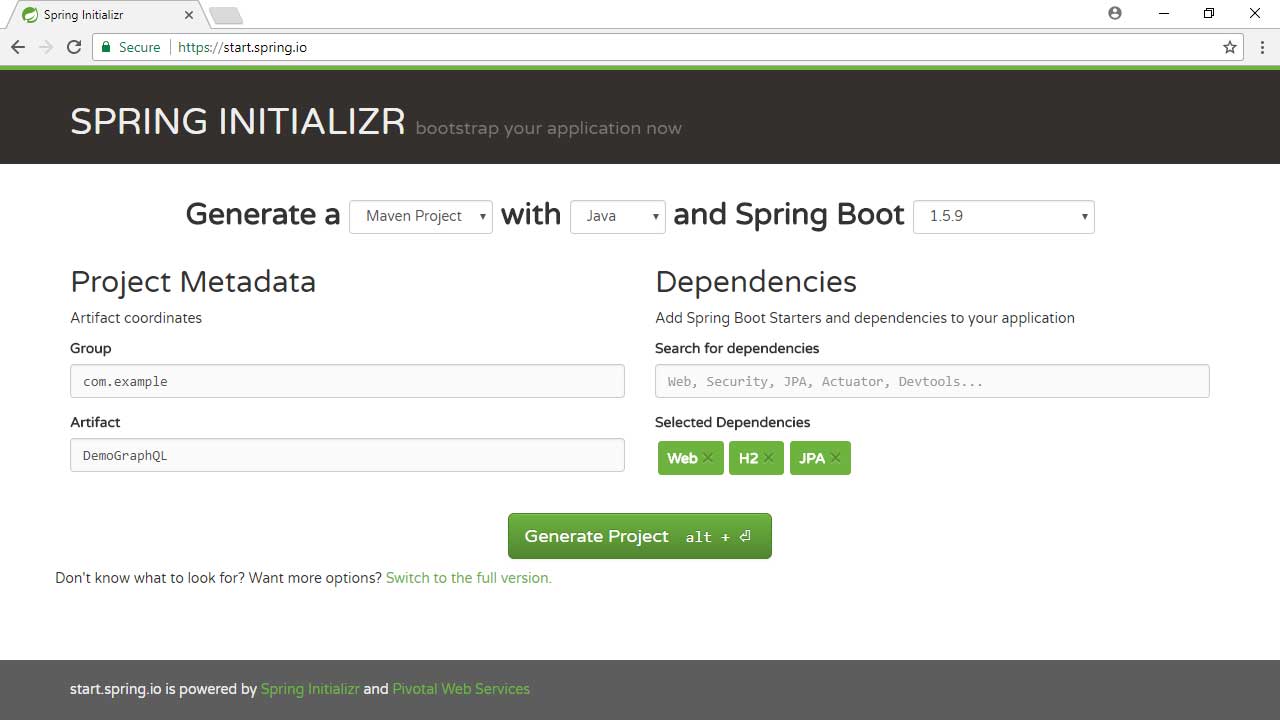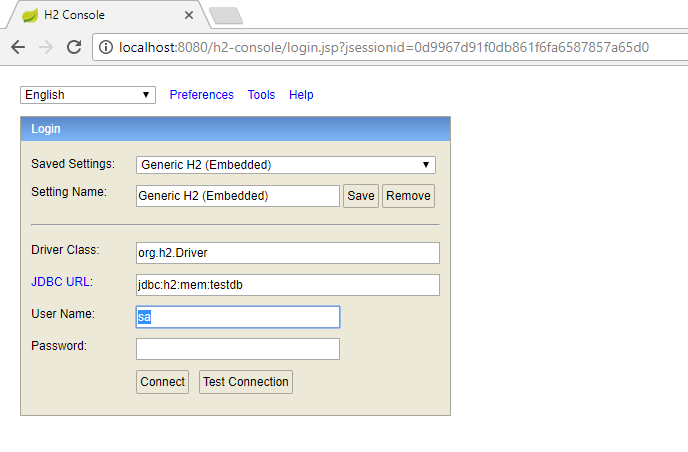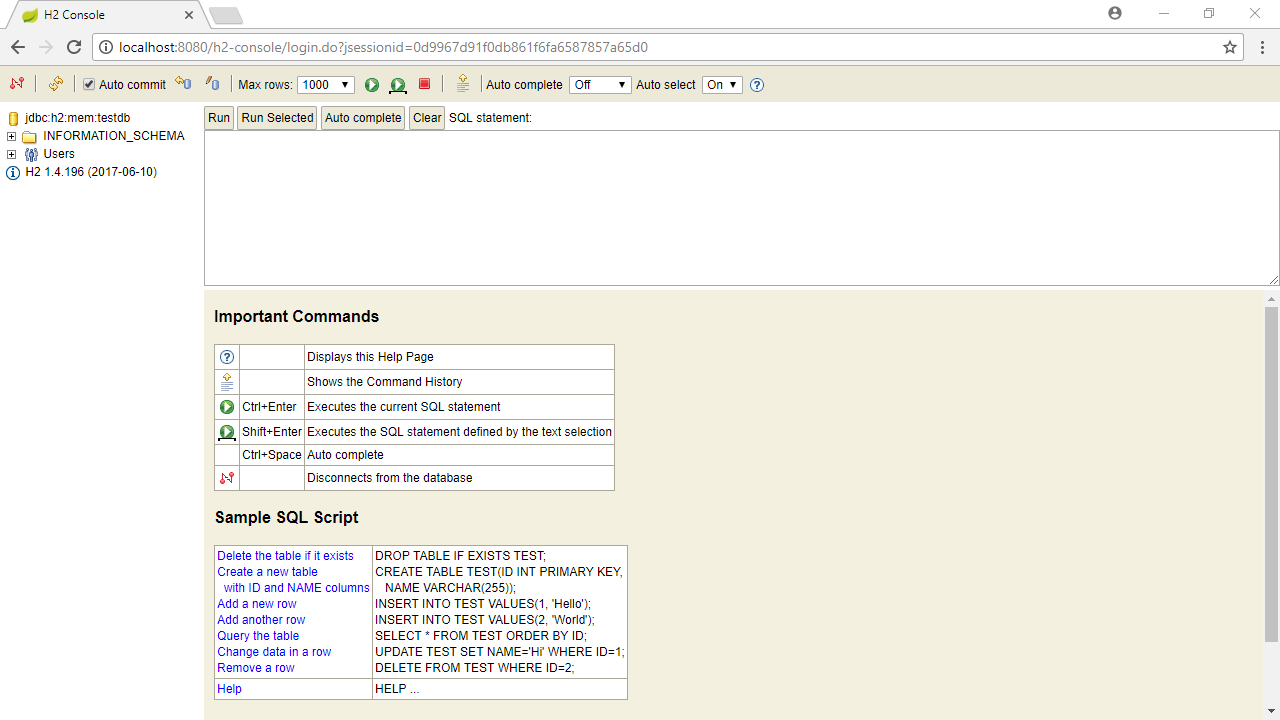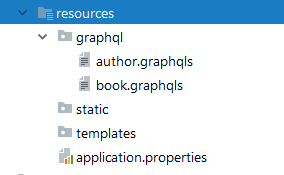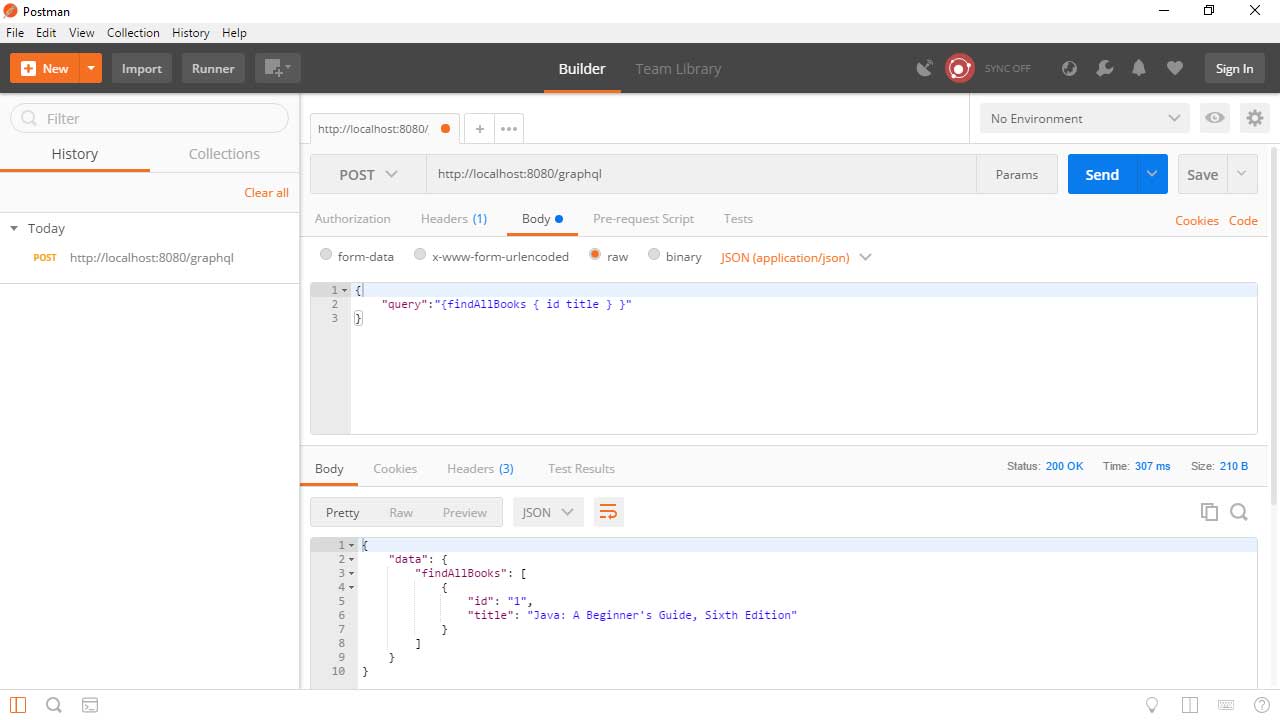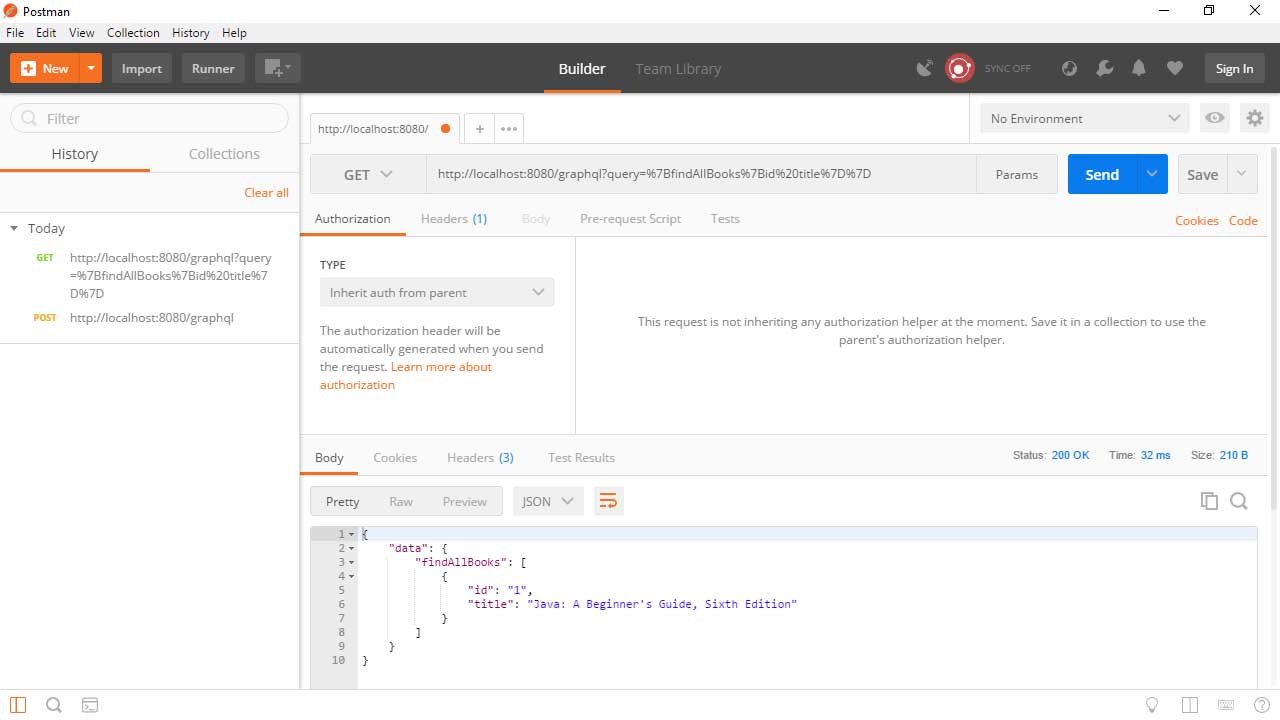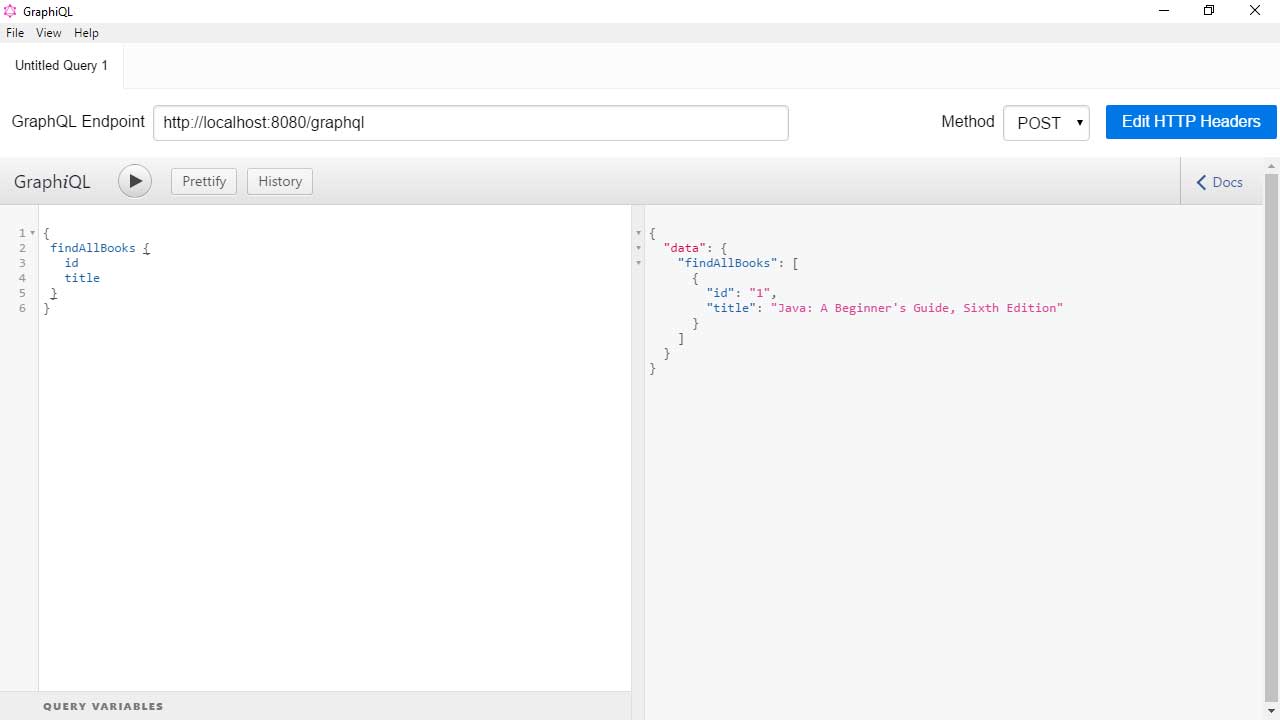Building a GraphQL Server with Spring Boot
Learn how to build a GraphQL server that will expose an API to create, update and delete entities of type Book with attributes such as ID, Title, ISBN and more.
Jan 10, 2019 • 38 Minute Read
Introduction
The Representational State Transfer (REST) architecture is the most popular way to expose data from a server through an API.
REST defines a set of principles that must be followed. There's a certain degree of freedom, but the clients have to be adapted to the way in which the resources are represented on the server side, which makes REST not a good fit for some cases.
GraphQL is a query language that offers an alternative model to developing APIs using a strong type system to provide a detailed description of an API.
In this tutorial, you're going to learn how to build a GraphQL server that will expose an API to create, update and delete entities of type Book with the following attributes:
- ID
- Title
- ISBN
- Page count
- Author
Author will be a complex type with the following attributes:
- ID
- First name
- Last name
You'll define these types in a GraphQL schema using a special Graphql DSL called IDL. You'll also create resolvers, queries, mutations, error handlers and the rest of the infrastructure for the server.
This tutorial will use:
- Java 9
- Spring Boot 1.5.9 with an embedded H2 database
- graphql-java, a GraphQL Java implementation
- GraphiQL, an app for editing and testing GraphQL queries/mutations (you'll learn how to use its web version)
- Maven (but you can use Gradle if you prefer it)
At the end of the tutorial, you'll have a strong foundation to build APIs with GraphQL using Spring Boot.
You can find the entire source code of this project on this GitHub repository.
Let's start by talking about GraphQL.
What is GraphQL?
GraphQL is a query language for APIs created by Facebook in 2012, open-sourced in 2015, and now released as a specification.
GraphQL describes the data offered by an API through a schema that contains:
-
Data types and relationships between them
-
A set of operations:
- Queries to get data
- Mutations to create, update, and delete data
For example, the following snippet defines the types Song and Artist along with their attributes and relationship between them:
type Song {
id: ID!
title: String!
duration: Int!
genre: String!
artist: Artist!
}
type Artist {
id: ID!
name: String!
country: String!
songs: [Song]
}
Notice that the fields are typed. These types can be scalar types (Int, Float, String, Boolean and ID) or references to other types defined in the specification.
You can also specify if they are required (!) or if they are an array ([]). Here you can find more information about object types and fields.
Query operations are also treated as types. They declare fields that represent the available operations. For example, you can define query operations to get all the songs and filter the songs by genre:
type SongQueries {
allSongs: [Song]
filterSongsByGenre(genre: String!): [Song]
}
schema {
query: SongQueries
}
By specifying a return type, GraphQL allows you to request only the information you need from a resource. Here's a sample query to get the name of all the rock songs:
{
filterSongsByGenre(genre: "rock") {
title
}
}
And even request the information of related resources:
{
filterSongsByGenre(genre: "rock") {
title
artist {
name
country
}
}
}
These queries are typically sent over HTTP to a single server endpoint (unlike a REST architecture, where there are different endpoints for different resources).
The response is typically sent using JSON. For example, here's a sample response to the first query:
{
"data": {
"filterSongsByGenre": [
{"title": "Song #0" },
{"title": "Song #1" }
]
}
}
In a similar way, you can define mutations to perform modifications on these types (optionally defining Input types):
# ...
input SongInput {
title: String!
genre: String!
duration: Int!
artistID: ID!
}
type SongMutations {
newSong(song: SongInput!): Song
}
schema {
query: SongQueries
mutation: SongMutations
}
Here's a sample mutation based on the above declaration:
mutation {
newSong(sond: {
title: "Song #2",
duration: 122,
genre: "hrock",
artistID: 1,
}) {
id
title
genre
artist {
name
}
}
}
Beyond the convention of using mutations to modify data, an important distinction between queries and mutations is that queries are executed in parallel, while mutations are executed one after the other to avoid race conditions.
There's a lot more to learn about GraphQL, but these concepts (types, queries, and mutations) are the foundation.
Now let's see how Spring Boot can help us implement a GraphQL server in an easy way.
Spring Boot support for GraphQL
graphql-java is a Java library that implements the GraphQL specification.
You can add the library as a dependency on your project to start using it. At the time of writing this tutorial, the latest version is 6.0:
<!-- https://mvnrepository.com/artifact/com.graphql-java/graphql-java -->
<dependency>
<groupId>com.graphql-java</groupId>
<artifactId>graphql-java</artifactId>
<version>6.0</version>
</dependency>
However, you'll also want to use a library like GraphQL Java Tools to parse GraphQL schemas instead of describing your types programmatically. This library also maps them automatically to Java objects:
<!-- https://mvnrepository.com/artifact/com.graphql-java/graphql-java-tools -->
<dependency>
<groupId>com.graphql-java</groupId>
<artifactId>graphql-java-tools</artifactId>
<version>4.3.0</version>
</dependency>
If you're building a web application, you'll also want to use GraphQL Servlet, which implements a servlet that supports GET and POST requests for GraphQL queries:
<!-- https://mvnrepository.com/artifact/com.graphql-java/graphql-java-servlet -->
<dependency>
<groupId>com.graphql-java</groupId>
<artifactId>graphql-java-servlet</artifactId>
<version>4.7.0</version>
</dependency>
Integrating all these projects requires a lot of boilerplate code. Luckily, graphql-java is supported by Spring Boot with the use of the graphql-spring-boot-starter project.
You just have to add graphql-spring-boot-starter to your project:
<!-- https://mvnrepository.com/artifact/com.graphql-java/graphql-spring-boot-starter -->
<dependency>
<groupId>com.graphql-java</groupId>
<artifactId>graphql-spring-boot-starter</artifactId>
<version>3.10.0</version>
</dependency>
This starter will add and autoconfigure a GraphQL Servlet at /graphql and use a GraphQL schema library (like GraphQL Java Tools) to parse all the schema files found on the classpath.
Also, the following parameters will be available (via application.yml or application.properties) with these default values:
graphql:
servlet:
mapping: /graphql
enabled: true
corsEnabled: true
However, at the time of this writing, graphql-spring-boot-starter only works with Spring Boot 1.x, there's no support for Spring Boot 2 at the moment. According to this issue, support for Spring Boot 2 will be added when its general availability version is released (due by February 2018 at this moment).
Now let's bootstrap a Spring Boot application using Spring Initializr.
Setting up the project
Go to https://start.spring.io/ and choose the following options:
- Maven (or Gradle)
- Java
- Spring Boot 1.5.9
- com.example (or any other identifier) as the Group
- DemoGraphQL (or any other identifier) as the Artifact
- As dependencies:
- Web
- H2
- JPA
Generate the project, unzip the downloaded file, and open the project in your favorite IDE.
I'm going to use Java 9 so in pom.xml, let's start by changing the java version in the properties:
<properties>
...
<java.version>9</java.version>
</properties>
At this time, Spring Boot 1.x has some compatibility issues with Java 9. So we're going to remove spring-boot-devtools (if it's added to your project) and add the dependency jaxb-api:
<dependency>
<groupId>javax.xml.bind</groupId>
<artifactId>jaxb-api</artifactId>
<version>2.3.0</version>
</dependency>
Next, add the graphql-spring-boot-starter:
<dependency>
<groupId>com.graphql-java</groupId>
<artifactId>graphql-spring-boot-starter</artifactId>
<version>3.10.0</version>
</dependency>
It will add graphql-java and graphql-java-servlet as dependencies of your project, however, you still have to add a library to parse the GraphQL Schema. At this time, you have two options:
I'll add GraphQL Java Tools:
<dependency>
<groupId>com.graphql-java</groupId>
<artifactId>graphql-java-tools</artifactId>
<version>4.3.0</version>
</dependency>
For this tutorial, we're going to use an embedded H2 database, but since we removed spring-boot-devtools, we have to enable an embedded H2 database explicitly in src/main/resources/application.resources:
spring.h2.console.enabled=true
spring.h2.console.path=/h2-console
Update your Maven configuration in your IDE to download the dependencies if you haven't already, and run the main class of your project, in my case, com.example.DemoGraphQL. Alternatively, in a terminal window, you can execute mvnw spring-boot:run (or gradle bootRun if you're using Gradle).
Apart from some warnings, everything should look fine in the console logs. You can go to https://localhost:8080/h2-console/login.jsp and enter the following information:
- JDBC URL: jdbc:h2:mem:testdb
- User Name: sa
- Password: (empty)
When you press the Connect button, the console of the in-memory database should appear:
If everything is fine, you're ready to start writing the GraphQL schema.
Writing the Schema
At this point, if you go to https://localhost:8080/graphql, you'll see an error because nothing has been defined. So let's start with the GraphQL schema.
As said before, we're going to use the DSL language to create the schema instead of the programmatic way.
These schemas are written in .graphqls files, which can be placed anywhere in the classpath. So in src/main/resources/ create a graphql directory and inside of it, create the files author.graphqls and book.graphqls:
You can split up your schema into more than one file to keep it organized. However, there can be only one root Query and only one root Mutation types that will contain all the query and mutation operations.
So in the file author.graphqls, we're going to define the Author type and the query and mutation operations we're going to implement for this type:
type Author {
id: ID!
firstName: String!
lastName: String!
}
type Query {
findAllAuthors: [Author]!
countAuthors: Long!
}
type Mutation {
newAuthor(firstName: String!, lastName: String!) : Author!
}
And in the file book.graphqls, in addition to the Book type, we're going to extend the Query and Mutation types:
type Book {
id: ID!
title: String!
isbn: String!
pageCount: Int
author: Author
}
extend type Query {
findAllBooks: [Book]!
countBooks: Long!
}
extend type Mutation {
newBook(title: String!, isbn: String!, pageCount: Int, author: ID!) : Book!
deleteBook(id: ID!) : Boolean
updateBookPageCount(pageCount: Int!, id: ID!) : Book!
}
This way, at runtime, the Query type will contain all the author and book operation, as it was defined like:
type Query {
findAllAuthors: [Author]!
countAuthors: Long!
findAllBooks: [Book]!
countBooks: Long!
}
Just like the Mutation type:
type Mutation {
newAuthor(firstName: String!, lastName: String!) : Author!
newBook(title: String!, isbn: String!, pageCount: Int, author: ID!) : Book!
deleteBook(id: ID!) : Boolean
updateBookPageCount(pageCount: Int!, id: ID!) : Book!
}
About the types you can assign to fields or to the return values of operations, graphql-java supports the following types:
- Scalar:
- String
- Boolean
- Int
- Float
- ID
- Long
- Short
- Byte
- Float
- BigDecimal
- BigInteger
- Object (like the Book or Author types defined above)
- Interface, for example:
interface Shape { color: String!, size: Int! } type Triangle implements Shape { } type Square implements Shape { } type Query { searchByColor(color: String!): [Shape]! } - Union
type Triangle { # fields ... } type Square { # fields ... } union Shape = Triangle | Square type Query { searchByColor(sizes: Int!): [Shape]! } - InputObject
input BookInput { title: String! genre: String! duration: Int! artistID: ID! } - Enum
enum Shape { TRIANGLE SQUARE }Of course, you can also define your own types. See how the Scalar types are defined to give you an idea.
- Enum
- InputObject
- Union
Once you have a type defined, the library GraphQL Java Tools will map it to a Java object.
So let's create the package model and define an Author class with the constructors, getters and setters, equals, and hashCode methods:
import javax.persistence.*;
@Entity
public class Author {
@Id
@GeneratedValue(strategy=GenerationType.AUTO)
private Long id;
private String firstName;
private String lastName;
public Author() {
}
public Author(Long id) {
this.id = id;
}
public Author(String firstName, String lastName) {
this.firstName = firstName;
this.lastName = lastName;
}
public Long getId() {
return id;
}
public void setId(Long id) {
this.id = id;
}
public String getFirstName() {
return firstName;
}
public void setFirstName(String firstName) {
this.firstName = firstName;
}
public String getLastName() {
return lastName;
}
public void setLastName(String lastName) {
this.lastName = lastName;
}
@Override
public boolean equals(Object o) {
if (this == o) return true;
if (o == null || getClass() != o.getClass()) return false;
Author author = (Author) o;
return id.equals(author.id);
}
@Override
public int hashCode() {
return id.hashCode();
}
@Override
public String toString() {
return "Author{" +
"id=" + id +
", firstName='" + firstName + '\'' +
", lastName='" + lastName + '\'' +
'}';
}
}
The same applies to the Book class:
import javax.persistence.*;
@Entity
public class Book {
@Id
@GeneratedValue(strategy=GenerationType.AUTO)
private Long id;
private String title;
private String isbn;
private int pageCount;
@ManyToOne
@JoinColumn(name = "author_id",
nullable = false, updatable = false)
private Author author;
public Book() {
}
public Book(String title, String isbn, int pageCount, Author author) {
this.title = title;
this.isbn = isbn;
this.pageCount = pageCount;
this.author = author;
}
public Long getId() {
return id;
}
public void setId(Long id) {
this.id = id;
}
public String getTitle() {
return title;
}
public void setTitle(String title) {
this.title = title;
}
public String getIsbn() {
return isbn;
}
public void setIsbn(String isbn) {
this.isbn = isbn;
}
public int getPageCount() {
return pageCount;
}
public void setPageCount(int pageCount) {
this.pageCount = pageCount;
}
public Author getAuthor() {
return author;
}
public void setAuthor(Author author) {
this.author = author;
}
@Override
public boolean equals(Object o) {
if (this == o) return true;
if (o == null || getClass() != o.getClass()) return false;
Book book = (Book) o;
return id.equals(book.id);
}
@Override
public int hashCode() {
return id.hashCode();
}
@Override
public String toString() {
return "Book{" +
"id=" + id +
", title='" + title + '\'' +
", isbn='" + isbn + '\'' +
", pageCount=" + pageCount +
", author=" + author +
'}';
}
}
Notice that these classes are annotated @Entity, so they will represent the database's tables.
For scalar fields, getter and setter methods will be enough. However, for fields with complex types (like author in Book), you have to use Resolver objects to resolve the value of those fields.
Resolver objects implement the interface GraphQLResolver. Create the package resolver, and inside of it, the resolver for the Book class:
public class BookResolver implements GraphQLResolver<Book> {
private AuthorRepository authorRepository;
public BookResolver(AuthorRepository authorRepository) {
this.authorRepository = authorRepository;
}
public Author getAuthor(Book book) {
return authorRepository.findOne(book.getAuthor().getId());
}
}
GraphQL Java Tools works with four types of Resolver classes:
- GraphQLResolver<T> to resolve complex types.
- GraphQLQueryResolver to define the operations of the root Query type.
- GraphQLMutationResolver to define the operations of the root Mutation type.
- GraphQLSubscriptionResolver to define the operations of the root Subscription type.
Subscriptions allows you to subscribe to a reactive source. They won't be reviewed in this tutorial, but the repositories for the Author and Book entities, and the GraphQLQueryResolver and GraphQLMutationResolver classes will be in the next section.
Implementing the API
Let's start by creating the repositories. Spring Boot makes it really easy to create CRUD repositories.
In the repository package, create the interface AuthorRepository:
public interface AuthorRepository extends CrudRepository<Author, Long> { }
And the interface BookRepository:
public interface BookRepository extends CrudRepository<Book, Long> { }
Spring Boot will generate an implementation with methods to find, save, count and delete for the Author and Book entities.
This way, implementing a GraphQLQueryResolver is straightforward. In the resolver package, create the class Query:
public class Query implements GraphQLQueryResolver {
private BookRepository bookRepository;
private AuthorRepository authorRepository;
public Query(AuthorRepository authorRepository, BookRepository bookRepository) {
this.authorRepository = authorRepository;
this.bookRepository = bookRepository;
}
public Iterable<Book> findAllBooks() {
return bookRepository.findAll();
}
public Iterable<Author> findAllAuthors() {
return authorRepository.findAll();
}
public long countBooks() {
return bookRepository.count();
}
public long countAuthors() {
return authorRepository.count();
}
}
Creating the Mutation class requires a little more work but it's still straightforward. After injecting the author and book repositories in the constructor:
public class Mutation implements GraphQLMutationResolver {
private BookRepository bookRepository;
private AuthorRepository authorRepository;
public Mutation(AuthorRepository authorRepository, BookRepository bookRepository) {
this.authorRepository = authorRepository;
this.bookRepository = bookRepository;
}
}
Based on the GraphQL schema, you need to define the methods to create new authors and books, taking the declared parameters and saving the entities using the corresponding repositories:
public class Mutation implements GraphQLMutationResolver {
// ...
public Author newAuthor(String firstName, String lastName) {
Author author = new Author();
author.setFirstName(firstName);
author.setLastName(lastName);
authorRepository.save(author);
return author;
}
public Book newBook(String title, String isbn, Integer pageCount, Long authorId) {
Book book = new Book();
book.setAuthor(new Author(authorId));
book.setTitle(title);
book.setIsbn(isbn);
book.setPageCount(pageCount != null ? pageCount : 0);
bookRepository.save(book);
return book;
}
}
Notice that the GraphQL type ID can be converted to the Java types String, Integer, and Long and the parameters names of the method and the schema don't have to match. However, you have to take into account the number of parameters, their type, and whether they are optional or not.
Next, here's the delete method:
public class Mutation implements GraphQLMutationResolver {
// ...
public boolean deleteBook(Long id) {
bookRepository.delete(id);
return true;
}
}
And finally, the method to update the book's page count:
public class Mutation implements GraphQLMutationResolver {
// ...
public Book updateBookPageCount(Integer pageCount, Long id) {
Book book = bookRepository.findOne(id);
book.setPageCount(pageCount);
bookRepository.save(book);
return book;
}
}
However, there's something about this method is not quite right.
What if the ID passed as argument is an invalid one?
The method will throw a NullPointerException when the book to be updated cannot be found. This will be translated to a Internal server error on the client-side.
But the thing is that by default, any unhandled exception on the server-side will reach the client as a generic Internal server error.
Take a look at the default GraphQL Servlet's error handler:
public class DefaultGraphQLErrorHandler implements GraphQLErrorHandler {
// ...
@Override
public List<GraphQLError> processErrors(List<GraphQLError> errors) {
final List<GraphQLError> clientErrors = filterGraphQLErrors(errors);
if (clientErrors.size() < errors.size()) {
// Some errors were filtered out to hide implementation - put a generic error in place.
clientErrors.add(new GenericGraphQLError("Internal Server Error(s) while executing query"));
errors.stream()
.filter(error -> !isClientError(error))
.forEach(error -> {
if(error instanceof Throwable) {
log.error("Error executing query!", (Throwable) error);
} else {
log.error("Error executing query ({}): {}", error.getClass().getSimpleName(), error.getMessage());
}
});
}
return clientErrors;
}
// ...
}
Only the client errors (for example, when you misspell the name of a field) are processed. The rest of the errors are treated as a generic error and then logged.
If you want the client to get the correct message, the first thing you need to do is create a custom exception that implements GraphQLError. For example, a BookNotFoundException class:
public class BookNotFoundException extends RuntimeException implements GraphQLError {
private Map<String, Object> extensions = new HashMap<>();
public BookNotFoundException(String message, Long invalidBookId) {
super(message);
extensions.put("invalidBookId", invalidBookId);
}
@Override
public List<SourceLocation> getLocations() {
return null;
}
@Override
public Map<String, Object> getExtensions() {
return extensions;
}
@Override
public ErrorType getErrorType() {
return ErrorType.DataFetchingException;
}
}
GraphQLError provides a field called extensions to pass additional data to the error object send to the client. In this case, we'll use it to pass the invalid book ID.
This way, in the updateBookPageCountmethod, if the book cannot be found, we throw this exception:
public class Mutation implements GraphQLMutationResolver {
// ...
public Book updateBookPageCount(Integer pageCount, Long id) {
Book book = bookRepository.findOne(id);
if(book == null) {
throw new BookNotFoundException("The book to be updated was not found", id);
}
book.setPageCount(pageCount);
bookRepository.save(book);
return book;
}
}
By using an exception as a GraphQLError, the client will receive the complete stack trace in addition to the exception message.
If you don't want this behavior, you can create an adapter class to hide the exception (which can be wrapped in an ExceptionWhileDataFetching class):
public class GraphQLErrorAdapter implements GraphQLError {
private GraphQLError error;
public GraphQLErrorAdapter(GraphQLError error) {
this.error = error;
}
@Override
public Map<String, Object> getExtensions() {
return error.getExtensions();
}
@Override
public List<SourceLocation> getLocations() {
return error.getLocations();
}
@Override
public ErrorType getErrorType() {
return error.getErrorType();
}
@Override
public List<Object> getPath() {
return error.getPath();
}
@Override
public Map<String, Object> toSpecification() {
return error.toSpecification();
}
@Override
public String getMessage() {
return (error instanceof ExceptionWhileDataFetching) ? ((ExceptionWhileDataFetching) error).getException().getMessage() : error.getMessage();
}
}
So now the only thing missing is to redefine GraphQL's default error handler.
You can create a Spring @Configuration class or use the main class of the application annotated with @SpringBootApplication to create a bean of type GraphQLErrorHandler to replace the default error handler implementation:
@SpringBootApplication
public class DemoGraphQlApplication {
public static void main(String[] args) {
SpringApplication.run(DemoGraphQlApplication.class, args);
}
@Bean
public GraphQLErrorHandler errorHandler() {
return new GraphQLErrorHandler() {
@Override
public List<GraphQLError> processErrors(List<GraphQLError> errors) {
List<GraphQLError> clientErrors = errors.stream()
.filter(this::isClientError)
.collect(Collectors.toList());
List<GraphQLError> serverErrors = errors.stream()
.filter(e -> !isClientError(e))
.map(GraphQLErrorAdapter::new)
.collect(Collectors.toList());
List<GraphQLError> e = new ArrayList<>();
e.addAll(clientErrors);
e.addAll(serverErrors);
return e;
}
protected boolean isClientError(GraphQLError error) {
return !(error instanceof ExceptionWhileDataFetching || error instanceof Throwable);
}
};
}
}
If you don't mind showing the exception stack trace to your clients, you can just return the list of errors that the method processErrors receives as an argument.
But in this case, we do. So we first collect the client errors as they are, then the server errors, converting them to the adapter type (GraphQLErrorAdapter), and finally returning a list of all the errors collected.
While we're at it, let's also declare as Spring beans the resolvers for the Book, Query, and Mutation types:
@SpringBootApplication
public class DemoGraphQlApplication {
// ...
@Bean
public BookResolver authorResolver(AuthorRepository authorRepository) {
return new BookResolver(authorRepository);
}
@Bean
public Query query(AuthorRepository authorRepository, BookRepository bookRepository) {
return new Query(authorRepository, bookRepository);
}
@Bean
public Mutation mutation(AuthorRepository authorRepository, BookRepository bookRepository) {
return new Mutation(authorRepository, bookRepository);
}
}
And if you want, with a CommandLineRunner bean, you can insert some data into the database:
@SpringBootApplication
public class DemoGraphQlApplication {
// ...
@Bean
public CommandLineRunner demo(AuthorRepository authorRepository, BookRepository bookRepository) {
return (args) -> {
Author author = new Author("Herbert", "Schildt");
authorRepository.save(author);
bookRepository.save(new Book("Java: A Beginner's Guide, Sixth Edition", "0071809252", 728, author));
};
}
}
And that's it. Let's test the application.
Testing with GraphiQL
Run the application and go to https://localhost:8080/graphql/schema.json. You should see a description of the GraphQL schema, something like this:
{
"data": {
"__schema": {
"queryType": {
"name": "Query"
},
"mutationType": {
"name": "Mutation"
},
"subscriptionType": null,
"types": [
{
"kind": "OBJECT",
"name": "Query",
"description": "",
"fields": [
{
"name": "findAllAuthors",
"description": "",
"args": [],
"type": {
"kind": "NON_NULL",
"name": null,
"ofType": {
"kind": "LIST",
"name": null,
"ofType": {
"kind": "OBJECT",
"name": "Author",
"ofType": null
}
}
},
"isDeprecated": false,
"deprecationReason": null
},
....
]
}
]
}
}
}
{
findAllBooks {
id
title
}
}
The request could be sent via HTTP POST as JSON in this way:
{
"query":"{findAllBooks { id title } }"
}
Here's how it looks in Postman:
You can also send a GET request URL encoded, so a query like:
http://localhost:8080/graphql?query={findAllBooks{id title}}
It will have to be sent like:
http://localhost:8080/graphql?query=%7BfindAllBooks%7Bid%20title%7D%7D
But as you can see, this could become a painful process when working with complex queries.
Luckily, we can use GraphiQL, an Electron app that you can install to test your GraphQL endpoint:
There's a documentation tab on the right where you can see all the queries and mutations available and the app even has autocompletion for types and fields:
If you don't want to install the app, there's a web version you can incorporate into your application.
There's a Spring Boot starter for this version. Just add the following dependency:
<!-- https://mvnrepository.com/artifact/com.graphql-java/graphiql-spring-boot-starter -->
<dependency>
<groupId>com.graphql-java</groupId>
<artifactId>graphiql-spring-boot-starter</artifactId>
<version>3.10.0</version>
</dependency>
Save the changes and run the application again. Now go to https://localhost:8080/graphiql and execute a query, for example:
{
findAllBooks {
id
isbn
title
pageCount
author {
firstName
lastName
}
}
}
The result should be something like:
These are the available Spring Boot configuration parameters for GraphiQL with their default values:
graphiql:
mapping: /graphiql
endpoint: /graphql
enabled: true
This means that if you change the endpoint where the GraphQL servlet is deployed, you'll also have to change the GraphiQL configuration (in application.properties):
graphql.servlet.mapping: /graphql2
graphiql.mapping: /graphiql
graphiql.endpoint: /graphql2
Otherwise, you'll get an error like the following:
{
"timestamp": 1513702998134,
"status": 404,
"error": "Not Found",
"message": "No message available",
"path": "/graphql2"
}
Now try some queries.
For example, to create a new book:
mutation {
newBook(
title: "Java: The Complete Reference, Tenth Edition",
isbn: "1259589331",
author: 1) {
id title
}
}
To update the page count of a book:
mutation {
updateBookPageCount(pageCount: 1344, id: 2) {
id pageCount
}
}
To delete a book:
mutation {
deleteBook(id:2)
}
You can also watch the modifications performed by these mutations on the database. And don't forget to try the case where there's no book to update:
mutation {
updateBookPageCount(pageCount: 1344, id: 20) {
id pageCount
}
}
Conclusion
GraphQL is a flexible and powerful alternative to REST for building APIs. Here are some points to remember:
- GraphQL is a query language that is independent of the source of the data (database, web service, etc.).
- GraphQL describes the data that an API provides via a strong typing system.
- Through a schema, GraphQL declares the resources, relationships between them, and operations available.
- All operations go through a single endpoing that can be accessed through HTTP.
There's a lot more to learn about GraphQL, of course. Here are some good resources:
You can find the entire source code of the project on GitHub.
Contact me if you have questions or problems. Thanks for reading.
Advance your tech skills today
Access courses on AI, cloud, data, security, and more—all led by industry experts.

